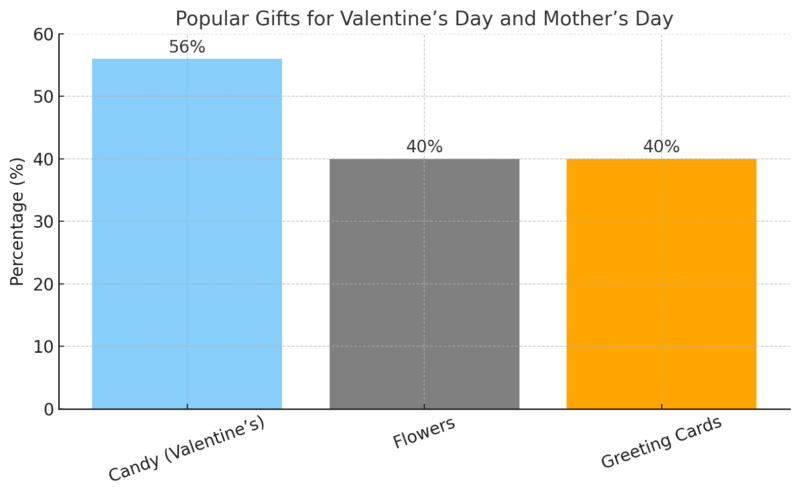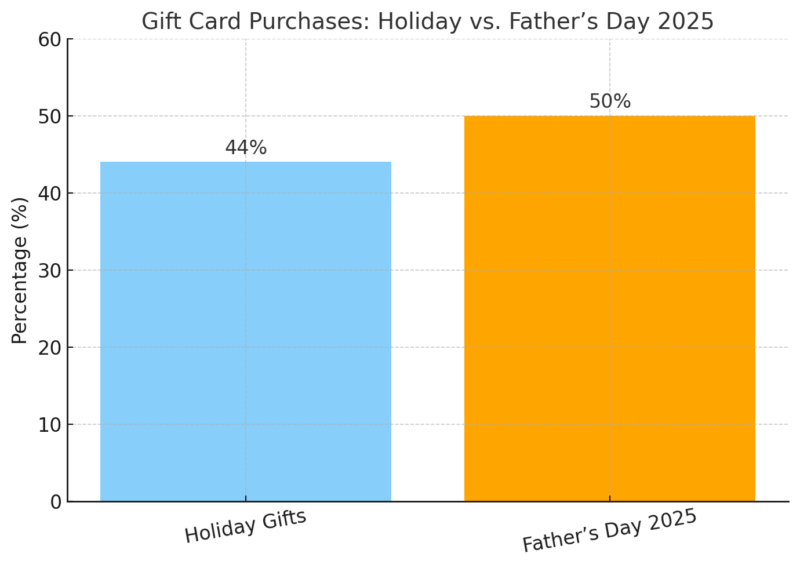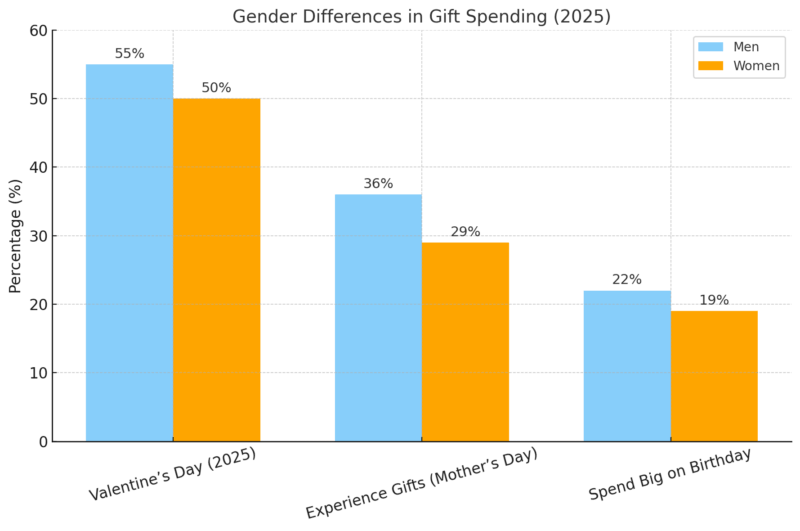Americans spend hundreds of billions of dollars on gifts each year, across holidays and personal occasions. The average American spends roughly 1,638$ per person annually on gifts for others, according to giftafeeling.com.
This includes major holidays like Christmas, birthdays, weddings, Valentine’s Day, Mother’s Day, Father’s Day, and more. In 2025, gift spending is reaching new highs in several categories, reflecting both strong consumer enthusiasm and shifting trends in what, how, and where people are gifting.
Table of Contents
ToggleSpending by Occasion: Holidays and Life Events
Different occasions drive different levels of spending. Winter holidays (Christmas/Hanukkah) remain the single biggest gift-giving event of the year.
But other holidays and life events also command significant budgets. Here’s how gift spending breaks down by occasion in recent years:
Winter Holidays (Christmas Season)
@wallstreetjournal How much are you spending on holiday gifts? People plan to buy an average of nine presents this year compared with 16 last year, according to Deloitte consulting’s annual holiday shopping survey of 5,000 respondents in September. Total anticipated spending per household was $1,455, down from $1,463 a year ago, Deloitte said. #wsj #thewallstreetjournal #wallstreetjournal #holiday #gifts #holidayshopping #spending #money ♬ original sound – The Wall Street Journal
The end-of-year holidays see the highest gift expenditures. American consumers planned to spend about $1,012 on Christmas and holiday gifts in 2024, up from $975 in 2023, according to news.gallup.com. (For context, this figure dipped to $867 in 2022 amid high inflation.)
In total, this translates to well over $200 billion nationwide spent on holiday gifts alone. The winter holidays far surpass any other occasion in average gift budget, underscoring why this season is critical for retailers.
Birthday
Birthday gifts are a major year-round expense. In a recent survey, 49% of Americans said they spend the most on birthday presents, more than on any other single life event, as noted by lendingtree.com. While there isn’t a single “holiday” total for birthdays, many people give multiple birthday gifts per year.
About 39% of Americans spend between $100 and $499 on gifts for others’ celebrations in a typical year, and an additional 18% spend between $500 and $999 – much of this likely goes toward birthdays. This makes birthdays one of the top occasions for gift spending throughout the year.
Weddings

Americans also shell out for wedding gifts. According to industry data, the average wedding gift spend is about $150 per guest. (Close friends and family tend to spend a bit more, around $160, while more distant acquaintances might spend ~$100–$140).
Considering there are roughly 2 million weddings in the U.S. each year, these gifts add up to a substantial total.
Notably, younger adults have shown a willingness to spend more on wedding presents – one poll found Gen Z respondents planned to spend about $275 on a wedding gift, versus only $98 among Baby Boomers.
Valentine’s Day
Valentine’s Day 2025 set a new record, with Americans expected to spend $27.5 billion on gifts, dining, and other Valentine’s Day-related items, stated to nrf.com. This is up from about $25.8 billion in 2024 and slightly above the pre-pandemic record of $27.4 billion set in 2020.
On an individual level, consumers planned to spend approximately $189 per person for Valentine’s Day 2025 (up from $186 in 2024). Popular spending categories include candy, flowers, cards, jewelry, and evenings out.
In 2023, for example, Americans spent $5.5 billion on jewelry and $4.4 billion on special evenings out for Valentine’s, among other gifts, as noted by crossstate.org.
Mother’s Day
Mother’s Day is the second-largest gift holiday after Christmas. In 2025, U.S. consumers were expected to spend $34.1 billion on Mother’s Day gifts and celebrations. This is slightly higher than 2024’s $33.5 billion and just shy of the all-time high of $35.7 billion in 2023.
On average, those celebrating planned to spend about $259 each on their Mother’s Day gifts/outings in 2025. Flowers (74% of shoppers), greeting cards (73%), and special outings like dinner or brunch (61%) are perennial favorite gifts. Notably, 84% of U.S. adults celebrate Mother’s Day in some way, showing the broad participation in this occasion.
Father’s Day
Father’s Day gift spending has also been climbing. In 2025, Americans are projected to spend a record $24.0 billion on Father’s Day gifts. This marks a jump from $22.4 billion in 2024 and exceeds the previous record of $22.9B set in 2023.
Average spending per person for Father’s Day is a bit lower than for Mother’s Day – about $199 per celebrant in 2025 (up from $190 in 2024). Around 76% of Americans celebrate Father’s Day, and typical gifts include greeting cards (given by 58% of shoppers), clothing (55%), special outings (53% plan an outing or experience), and gift cards (50%).
Other Occasions
Beyond the major holidays, Americans give gifts for graduations, new babies, anniversaries, retirements, and more. While each of these categories is smaller, they are not insignificant.
For example, 11% of people say graduation gifts are their biggest gift expense, and 10% cite gifts for a new baby as a top spending category (ahead of retirements at 3%).
Additionally, there are events like winter holidays other than Christmas (e.g., Hanukkah), and minor holidays (e.g, Easter, which sees ~$3.4B on gifts in the U.S.). All told, these occasions contribute to the year-round gift economy that retailers and consumers participate in.
To put the major holidays in perspective, the table below summarizes recent spending figures for key gift occasions:
Occasion
2023 Spending
2024 Spending
2025 Spending (est.)
Winter Holidays (Nov–Dec) – average per person
$975 avg.
$1,012 avg.
~$1,000+ avg. (record high)
Valentine’s Day
$25.9 B total
$25.8 B total
$27.5 B total (record)
Mother’s Day
$35.7 B total (record)
$33.5 B total
$34.1 B total
Father’s Day
$22.9 B total (record)
$22.4 B total
$24.0 B total (record)
Gift Cards (Holiday Season)
$29.3 B total
$28.6 B total
~$28–29 B (expected)
As the table suggests, 2023–2025 have seen record or near-record gift spending for many occasions. Despite economic uncertainties (inflation, etc.), Americans continue to spend generously on gifts for loved ones.
Mother’s Day 2023 and Father’s Day 2025 hit record highs, and Valentine’s Day 2025 was the largest ever. Even Christmas-season gift budgets, which dipped in 2022, are climbing back up – the average planned holiday gift spending in late 2024 was about 16% higher than two years prior.
What Types of Gifts Are Americans Buying?

Americans are evolving in how they approach gift-giving. While traditional physical items remain the backbone of the gift economy, digital options and experience-based gifts are gaining significant traction. Below is a detailed breakdown of the three major gift categories in 2025.
Gift Type
Key Stats (2025)
Trend
Popular Occasions
Physical Goods
54% buy clothing, 36% toys, 31% books/media, 30% candy
Stable but slowly declining
Holidays, Birthdays, Valentine’s
Gift Cards & Digital
$28.6–29.3B/year, 44% of holiday shoppers buy gift cards
Growing, especially for flexibility
Christmas, Father’s Day, and Last-minute gifts
Experience Gifts
30–36% plan experiences for major holidays, $5.4B on Valentine outings
Fastest growth post-COVID
Valentine’s, Mother’s/Father’s Day
1. Physical Goods Still Dominate
Tangible gifts continue to be the most common choice. These include clothing, electronics, books, toys, jewelry, and consumables like sweets and wine. In the 2024 holiday season:
For Valentine’s Day and Mother’s Day, popular gifts included:

Jewelry is a top-dollar category. Americans spent over $6.5 billion on jewelry just for Valentine’s Day 2025 alone, according to CNBC.
In short, physical gifts continue to account for the largest share of spending because of their familiarity and perceived value.
Gift-givers are also upgrading the presentation of physical items. Many now finish their parcels with branded add-ons like Vograce custom washi tape, wrapping plain boxes or clear Vograce foil sleeves in eye-catching, personalized patterns.
The extra splash of color and branding turns an ordinary sweater or book into an Instagram-ready moment, especially popular for birthdays, bridal showers, and small-business “thank-you” gifts.
2. Gift Cards and Digital Gifts Growing Rapidly
Gift cards offer flexibility and convenience, making them one of the most frequently purchased gift types. These hybrid gifts sit between physical and digital formats:
- In 2023, Americans spent $29.3 billion on gift cards during the holidays
- In 2024, the estimate was $28.6 billion
- On average, people gave 3–4 cards per person, totaling $170 per giver
Gift cards were especially popular for:

Digital gifts beyond cards—such as streaming subscriptions, e-books, and digital games—are also increasing in popularity. A notable example: 43% of Father’s Day shoppers in 2025 planned to give a subscription box, up from 34% in 2019.
These options appeal to modern givers who value convenience, customization, and last-minute flexibility.
3. Experiences: One of the Fastest-Rising Gift Trends
Post-pandemic, Americans are placing greater value on experiential gifts—things that create memories rather than physical keepsakes. Examples include concert tickets, fine dining, weekend trips, spa packages, and creative classes.
- 32% of Valentine’s Day shoppers in 2023 planned to give an experience (a record high)
- 36% of men planned an experience for Mother’s Day 2025 (up from 29% in 2019)
- 30% of Father’s Day 2025 shoppers planned to experience gifts (up from 23% in 2019)
Valentine’s Day 2025 alone saw $5.4 billion spent on “evenings out.”
According to National Retail Federation surveys, nearly half of consumers now say they prefer unique or memory-making gifts over traditional items. This trend reflects a broader cultural shift: Americans increasingly want to share time, not just exchange objects.
Demographic Breakdowns

Gift spending habits in the United States vary considerably depending on age, gender, region, and income level. The latest data from 2023–2025 shows clear patterns in who spends the most, where, and why.
1. Spending by Age
Middle-aged Americans, particularly those aged 35 to 44, consistently spend the most on gifts. This group often has higher incomes, larger families, and broader social circles, which all contribute to elevated spending across holidays.
- On Valentine’s Day 2023, those aged 35–44 spent an average of $336, far above the national average of $193
- For Father’s Day 2025, the same age group budgeted $278.90, compared to the national average of $199
Younger adults (Gen Z and Millennials) generally spend less in total but are more likely to overspend relative to their income. Over 30% of Gen Z, Millennials, and Gen X reported going into debt to afford gifts, compared to only 13% of Baby Boomers, according to BadCredit.
Older adults (Boomers and seniors) tend to spend less overall, especially on holidays like Christmas, often due to fixed incomes or fewer recipients.
Gift Spending by Age Group
Age Group
Avg.. Valentine’s Day Spend (2023)
Avg.. Father’s Day Spend (2025)
Debt from Gift Spending
18–34 (Gen Z/Millennial)
~$150–200 (est.)
~$160–180 (est.)
Over 30% have incurred debt
35–44
$336
$278.90
Likely but unreported
45–64
$200–250 (est.)
$200–230 (est.)
Less than younger groups
65+ (Boomers)
$100–150 (est.)
Under $200
Only 13% have incurred debt
2. Spending by Gender
While both men and women actively participate in gift-giving, their behaviors differ.
- Women typically lead in holiday shopping volume, buying gifts across multiple family categories
- Men, however, tend to spend more per occasion, particularly on romantic or high-value gifts
For example:
- In 2025, 55% of men planned to celebrate Valentine’s Day, compared to 50% of women
- 36% of men planned to give an experience gift for Mother’s Day 2025, up from 29% in 2019.
- 22% of men vs 19% of women said they plan to “spend big” on their birthday to make up for previous years
Gender Differences in Gift Spending

3. Spending by Region
Gift budgets also shift slightly by U.S. region. According to a 2023 Talker Research poll for Newsweek, Americans in the Northeast and Midwest planned to spend more on gifts than those in other parts of the country.
While exact numbers weren’t reported, the pattern is attributed to:
- Higher household incomes in urbanized regions like the Northeast
- Cultural gifting norms and holiday traditions
- More access to large retailers and events
Urban areas also typically show higher per-person spending than rural areas due to cost-of-living differences and access to shopping options.
Regional Trends in Gift Spending (2023 Insights)
Region
Spending Level
Reasoning
Northeast
Highest
High-income, urban centers, cultural gifting norms
Midwest
High
Strong holiday traditions and larger families
South
Moderate to Low
Lower avg. income, but strong gift culture
West
Moderate
Mixed urban/rural spread, varies by state
4. Spending by Income Level

Unsurprisingly, higher-income households spend more in absolute terms. But interestingly, middle-class earners often feel more financial strain from gift-giving.
Key stats:
- 47% of Americans earning under $35,000 spend less than $100 annually on gifts
- About 20% of earners making $100,000+ report spending more than $2,000 per year on gifts
- 40% of those earning $75K–$99K reported going into debt from gift expenses, higher than both lower and higher brackets
This suggests middle-income families often stretch their finances to meet social expectations or holiday traditions, despite not having the wealth buffer that higher earners enjoy.
Gift Spending and Debt by Income Level
Income Level
Avg.. Annual Gift Spending
Debt from Gifts
Under $35,000
Under $100
~30% report some debt
$35K–$74K
$200–$800 (est.)
30–35% report debt
$75K–$99K
$800–$1,500+
40% report debt
$100K+
$1,500–$2,500+
~25% report debt
Conclusion
In 2025, Americans are spending more on gifts than ever, spreading generosity across many occasions. On average, U.S. consumers dedicate several hundred dollars a year to gift-giving – from the $1,000+ splurge during the winter holidays to the steady outlay on birthdays, weddings, and other events.
By occasion, the winter holidays still dwarf all else, but events like Mother’s Day ($ 34 B+) and Valentine’s Day (~$27B) command enormous expenditures as well.
We also see shifts in how Americans spend on gifts: experiences and digital gifts are taking a larger slice, online shopping is the go-to method for a plurality of shoppers, and gift cards remain a convenient staple.
Demographically, middle-aged adults and higher-income groups lead in raw spending, though gift-giving is a near-universal practice that cuts across all ages and incomes.
Importantly, the trend from 2020 to 2025 shows growth – even when external factors (like inflation or pandemics) intervene, Americans tend to eventually resume their yearly tradition of spending a substantial sum to celebrate loved ones.
Related Posts:
- States That Spend the Most (and Least) Per Resident…
- How Many People Die Each Day in the US in 2025? And…
- The Quality of Healthcare in The US Has Hit a…
- Unauthorized Immigration and US Border Crossing Data by Year
- World Population Grows by Over 71 Million in 2024,…
- U.S. Uninsured Rate by Year – 9 Key Trends Since 2010








